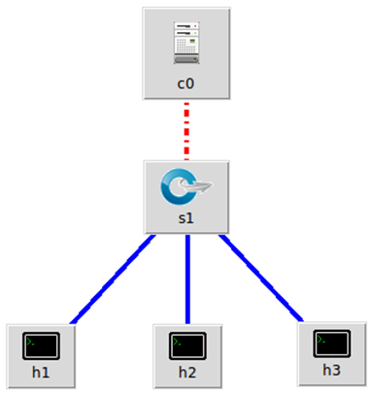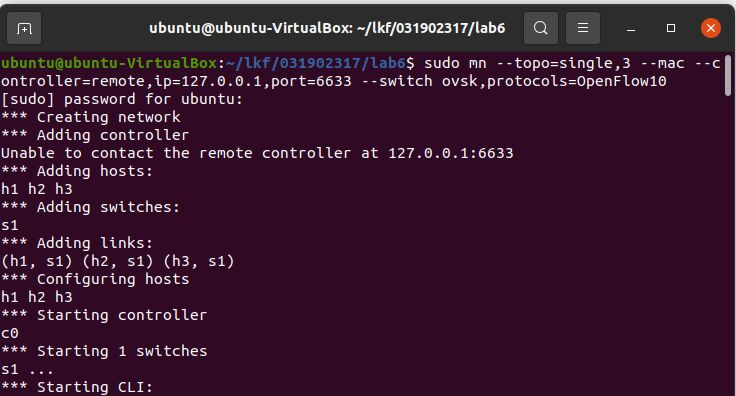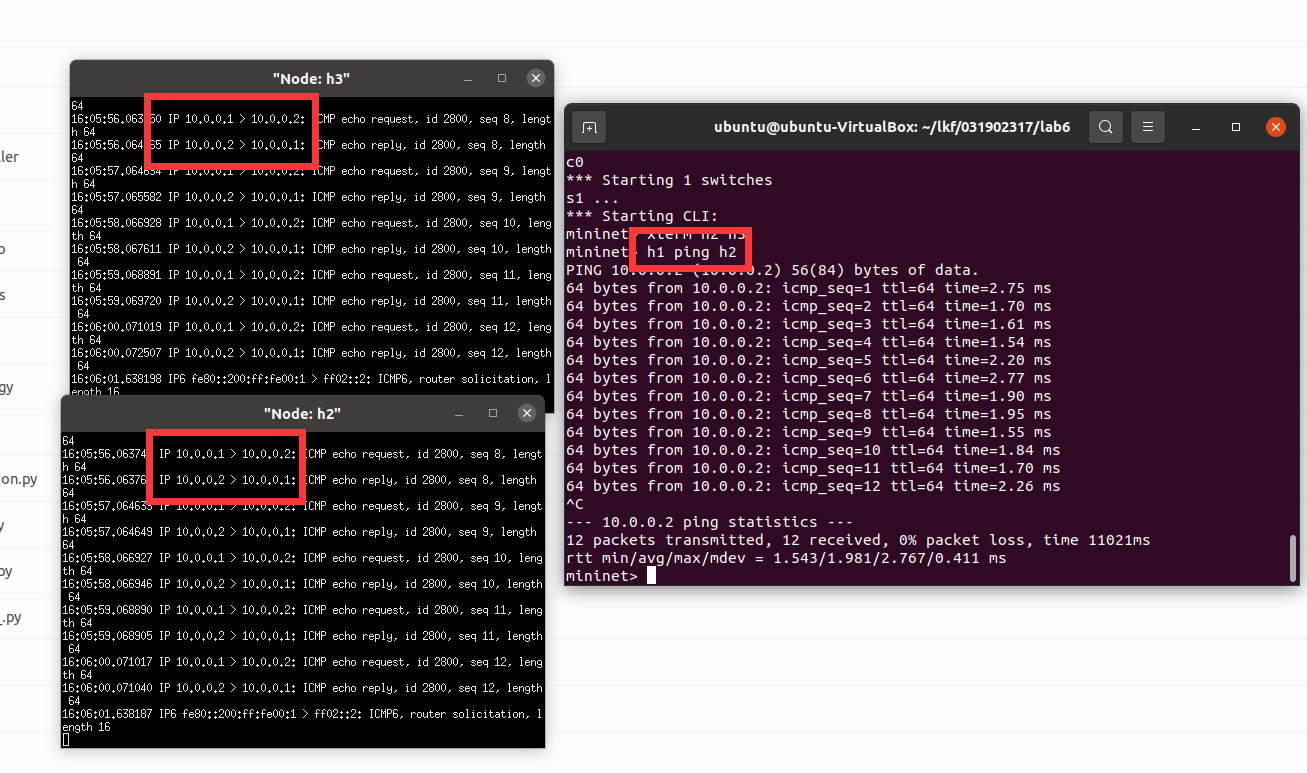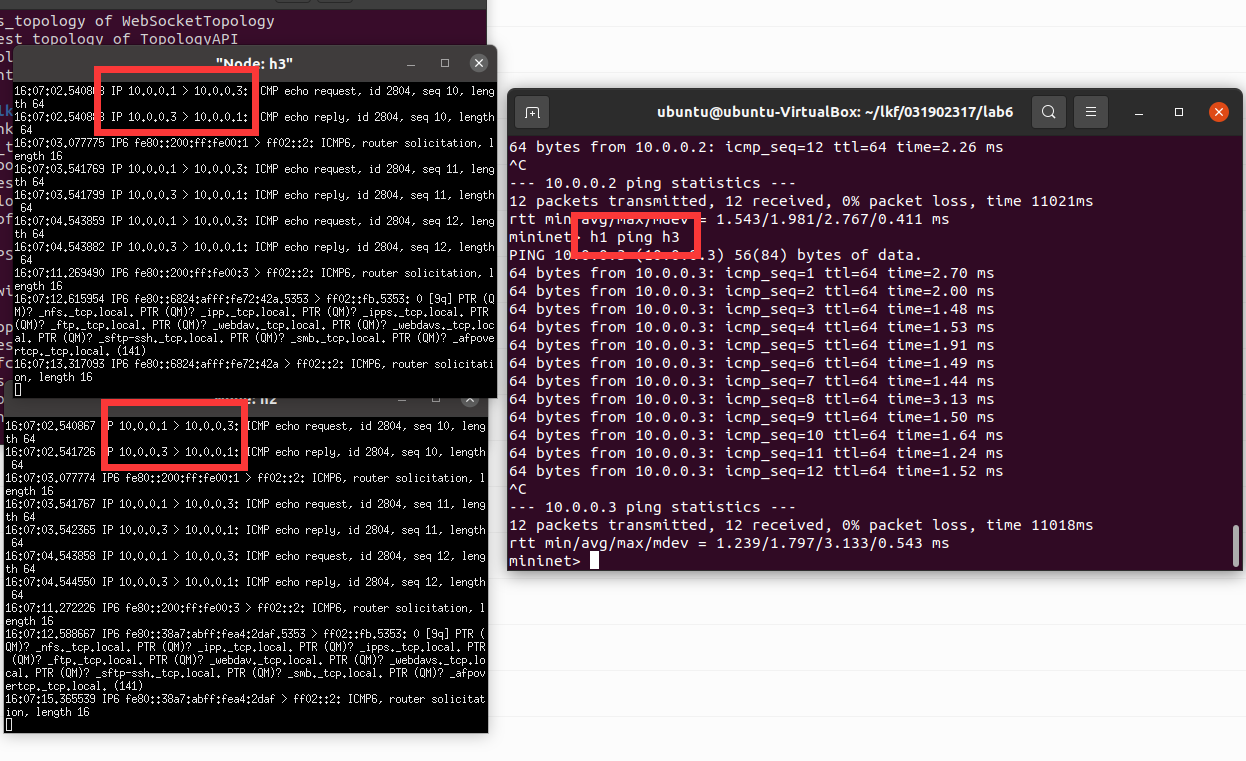实验6:开源控制器实践——RYU
实验6:开源控制器实践——RYU
第一部分:基本实验
实验步骤1
- 步骤内容:完成Ryu控制器的安装。
- ryu --version 结果截图
![]()
实验步骤2
- 步骤内容:搭建下图所示SDN拓扑,协议使用Open Flow 1.0,并连接Ryu控制器。
![]()
- 在终端输入命令:sudo mn --topo=single,3 --mac --controller=remote,ip=127.0.0.1,port=6633 --switch ovsk,protocols=OpenFlow10建立拓扑
![]()
实验步骤3
- 步骤内容:通过Ryu的图形界面查看网络拓扑。
- 首先在存放有ryu的文件目录内运行终端,并输入命令:ryu-manager ryu/ryu/app/gui_topology/gui_topology.py --observe-links连接ryu控制器
- 在浏览器中输入地址http://127.0.0.1:8080即可打开ryu的图形界面
- 查看到的网络拓扑如下:
![]()
实验步骤4
- 步骤内容:阅读Ryu文档的The First Application一节,运行并使用 tcpdump 验证L2Switch,分析和POX的Hub模块有何不同。
- 首先编写以下代码,并命名为L2Switch.py,存放于ryu/ryu/app文件夹内
- 终端运行命令:ryu-manager L2Switch.py
- 之后仿照实验六中的功能验证方法
执行结果
-
h1 ping h2
![]()
-
h1 ping h3
![]()
-
通过mininet命令行输入命令:dpctl dump-flows分别查看L2Switch模块及Hub模块下控制器流表信息
-
L2Switch
![]()
-
Hub
![]()
-
不同:二者虽然都是实现洪泛转发功能,但是POX的下发流表可以查看,但是L2Switch的下发流表无法查看。
第二部分:进阶实验
- 实验内容:阅读Ryu关于simple_switch.py和simple_switch_1x.py的实现,以simple_switch_13.py为例,完成其代码的注释工作,并回答下列问题:
- 注释结果如下:
# Copyright (C) 2011 Nippon Telegraph and Telephone Corporation.
#
# Licensed under the Apache License, Version 2.0 (the "License");
# you may not use this file except in compliance with the License.
# You may obtain a copy of the License at
#
# http://www.apache.org/licenses/LICENSE-2.0
#
# Unless required by applicable law or agreed to in writing, software
# distributed under the License is distributed on an "AS IS" BASIS,
# WITHOUT WARRANTIES OR CONDITIONS OF ANY KIND, either express or
# implied.
# See the License for the specific language governing permissions and
# limitations under the License.
#引入数据包
from ryu.base import app_manager
from ryu.controller import ofp_event
from ryu.controller.handler import CONFIG_DISPATCHER, MAIN_DISPATCHER
from ryu.controller.handler import set_ev_cls
from ryu.ofproto import ofproto_v1_3
from ryu.lib.packet import packet
from ryu.lib.packet import ethernet
from ryu.lib.packet import ether_types
class SimpleSwitch13(app_manager.RyuApp): #定义openflow版本
OFP_VERSIONS = [ofproto_v1_3.OFP_VERSION]
def __init__(self, *args, **kwargs):
super(SimpleSwitch13, self).__init__(*args, **kwargs)
# 定义保存mac地址到端口的一个映射
self.mac_to_port = {}
@set_ev_cls(ofp_event.EventOFPSwitchFeatures, CONFIG_DISPATCHER)
def switch_features_handler(self, ev):
datapath = ev.msg.datapath
ofproto = datapath.ofproto
parser = datapath.ofproto_parser
# install table-miss flow entry
#
# We specify NO BUFFER to max_len of the output action due to
# OVS bug. At this moment, if we specify a lesser number, e.g.,
# 128, OVS will send Packet-In with invalid buffer_id and
# truncated packet data. In that case, we cannot output packets
# correctly. The bug has been fixed in OVS v2.1.0.
match = parser.OFPMatch()
actions = [parser.OFPActionOutput(ofproto.OFPP_CONTROLLER,
ofproto.OFPCML_NO_BUFFER)]
self.add_flow(datapath, 0, match, actions)
def add_flow(self, datapath, priority, match, actions, buffer_id=None): #增加流表项
# 获取交换机信息
ofproto = datapath.ofproto
parser = datapath.ofproto_parser
inst = [parser.OFPInstructionActions(ofproto.OFPIT_APPLY_ACTIONS,
actions)]
if buffer_id:
mod = parser.OFPFlowMod(datapath=datapath, buffer_id=buffer_id,
priority=priority, match=match,
instructions=inst)
else:
mod = parser.OFPFlowMod(datapath=datapath, priority=priority,
match=match, instructions=inst)
datapath.send_msg(mod)
#触发Packet_In事件时调用_packet_in_handler函数
@set_ev_cls(ofp_event.EventOFPPacketIn, MAIN_DISPATCHER)
def _packet_in_handler(self, ev):
# If you hit this you might want to increase
# the "miss_send_length" of your switch
if ev.msg.msg_len < ev.msg.total_len:
self.logger.debug("packet truncated: only %s of %s bytes",
ev.msg.msg_len, ev.msg.total_len)
msg = ev.msg
datapath = msg.datapath
ofproto = datapath.ofproto
parser = datapath.ofproto_parser
in_port = msg.match['in_port']
pkt = packet.Packet(msg.data)
eth = pkt.get_protocols(ethernet.ethernet)[0]
#忽略LLDP类型
if eth.ethertype == ether_types.ETH_TYPE_LLDP:
# ignore lldp packet
return
dst = eth.dst
src = eth.src
dpid = format(datapath.id, "d").zfill(16)
self.mac_to_port.setdefault(dpid, {})
self.logger.info("packet in %s %s %s %s", dpid, src, dst, in_port)
# 了解mac地址以避免下次泛滥。
self.mac_to_port[dpid][src] = in_port
# 查看是否已经学习过该目的mac地址
if dst in self.mac_to_port[dpid]:
out_port = self.mac_to_port[dpid][dst]
else: # 否则进行洪泛
out_port = ofproto.OFPP_FLOOD
actions = [parser.OFPActionOutput(out_port)]
# 安装一个流以避免下次出现数据包_
if out_port != ofproto.OFPP_FLOOD:
match = parser.OFPMatch(in_port=in_port, eth_dst=dst, eth_src=src)
# 验证我们是否有有效的缓冲区id,如果是,则避免同时发送这两个id
# 流量模块和数据包输出
if msg.buffer_id != ofproto.OFP_NO_BUFFER:
self.add_flow(datapath, 1, match, actions, msg.buffer_id)
return
else:
self.add_flow(datapath, 1, match, actions)
data = None
if msg.buffer_id == ofproto.OFP_NO_BUFFER:
data = msg.data
out = parser.OFPPacketOut(datapath=datapath, buffer_id=msg.buffer_id,
in_port=in_port, actions=actions, data=data)
datapath.send_msg(out) #发送流表
a) 代码当中的mac_to_port的作用是什么?
保存mac地址到交换机端口的映射,为交换机自学习功能提供数据结构进行mac端口的存储
b) simple_switch和simple_switch_13在dpid的输出上有何不同
simple_switch的dpid赋值:dpid = datapath.id
simple_switch_13的dpid赋值:dpid = format(datapath.id, "d").zfill(16)
可见在simple_switch_13中,会在前端加上0以填充至16位,simple_switch直接输出dpid
c) 相比simple_switch,simple_switch_13增加的switch_feature_handler实现了什么功能?
实现了交换机以特性应答消息响应特性请求
d) simple_switch_13是如何实现流规则下发的?
在接收到packetin事件后,首先获取包学习,交换机信息,以太网信息,协议信息等。如果以太网类型是LLDP类型,则不予处理。如果不是,则获取源端口目的端口,以及交换机id,先学习源地址对应的交换机的入端口,再查看是否已经学习目的mac地址,如果没有则进行洪泛转发。如果学习过该mac地址,则查看是否有buffer_id,如果有的话,则在添加流动作时加上buffer_id,向交换机发送流表
e) switch_features_handler和_packet_in_handler两个事件在发送流规则的优先级上有何不同?
switch_features_handler下发流表的优先级相对较高
第三部分:反思与总结
实验难度
- 较难
实验过程遇到的困难及解决方法
- 首先是在ryu图形界面下查看网络拓扑过程中,输入127.0.0.1:8080的网址一直进不去,仔细看了一下之前执行连接ryu控制器中并没有正确连接
通过多次尝试,才发现需要在包含ryu的文件目录内打开才能成功。 - 接着就是在验证L2Switch模块时候,h1 ping h2一直失败,如下图
![]()
后面以为是L2Wwitch要存放在ryu内,也以为是没有先开启L2Wwitch模块的原因导致,也试着重启虚拟机,但是发现试了都没用,很疑惑。
之后也是懵懵懂懂地成功了(一直重复试)突然就可以了 - 在注释时候,对于没有学会python的人来说,注释实在有点难,不过好在文件里已经有英文版注释了,通过百度以及看了下其他同学的注释,
也算慢慢地弄懂了这个代码的功能。
个人感想
- 通过本次实验,使我对ryu的使用有了初步的认识与掌握,对L2Wwitch模块的洪泛转发功能有所了解,并且也能够区分出它和Hub模块的不同,
希望能在后面实验中灵活运用二者。如刚刚遇到的困难所说,我依然对那个h1 ping h2的失败很不能理解,而且虽然成功了,但是我并没做出
什么改动,很莫名其妙地就成了,本来想看看博客园其他同学的过程,参考一下,可惜都没找到可以解决这个问题的方法,不过倒是找到了一样遇到
困难的,哈哈。还有就是是时候抽空学习一下python了,真的很好用。












 浙公网安备 33010602011771号
浙公网安备 33010602011771号